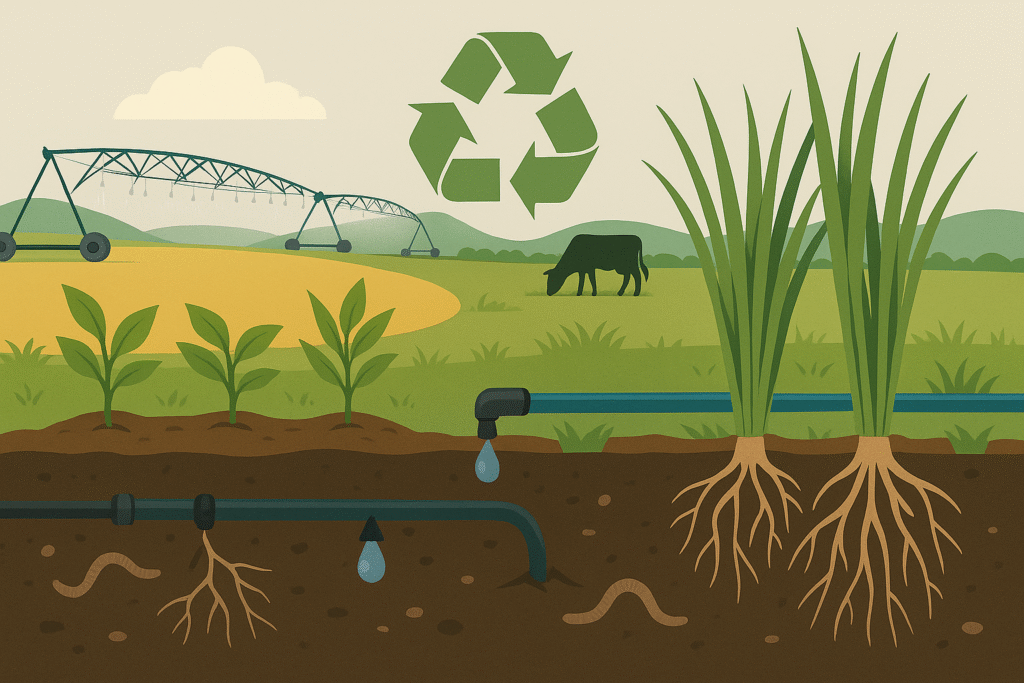
Soil Health and Farming: Building Strong Pastures and Crops
Introduction: Why Soil Health Matters Everywhere
Soil is the hidden foundation of life. It might just look like dirt to some people, but it’s alive with billions of microbes, fungi, insects, and organic matter that make farming possible.And not only crop or dairy farming, think about your veggie garden or orchards, healthy soil always matters.
Soil health and farming go hand in hand — it’s the foundation for strong pastures, resilient crops, and sustainable food production.”
For crop farmers, soil health means higher yields, better grain quality, and fewer pests. For pasture-based farmers, it means resilient grasslands that feed livestock year after year. And for city folks, it means healthy food, clean water, and a stable climate.
Read also our blog on; Regenerative Dairy Farming: Can It Heal the Land?
What Makes Soil “Healthy”?
Healthy soil is much more than brown earth under your boots. It:
- Holds water like a sponge, reducing drought stress.
- Provides nutrients for crops and grasses.
- Supports biodiversity, from worms to microbes.
- Prevents erosion by binding particles together.
Unhealthy soil, on the other hand, is compacted, low in nutrients, and prone to washing away in the rain.
Read also our blog on; Water Use in Dairy Farming: How Efficiency Can Save the Planet
Soil Health for Crop Farmers
For crop growers — whether corn, soybeans, wheat, or vegetables — soil is the engine of production.
- Crop Rotation: Alternating crops like corn, soy, and wheat breaks pest cycles and balances nutrients.
- Cover Crops: Rye, clover, or radishes planted between harvests keep soil covered, prevent erosion, and add organic matter.
- Reduced Tillage: Minimizing plowing protects soil microbes and keeps carbon in the ground.
Example: A wheat farmer who follows harvest with a cover crop of clover not only protects soil but also fixes nitrogen naturally, reducing fertilizer costs the next season.
Soil Health for Pasture Farmers
Pasture systems rely on strong root growth and soil structure. Healthy soil means more grass, deeper roots, and animals that graze without damaging the land.
- Rotational Grazing: Moving cattle, sheep, or goats between paddocks prevents overgrazing and gives pastures time to recover.
- Manure Management: Composting manure or applying effluent returns nutrients to the soil without overloading it.
- Legume Integration: Overseeding clover into pastures provides nitrogen and balances grasses.
Example: A dairy farmer who rotates cows every 24–48 hours sees stronger regrowth, healthier soil, and higher milk production.
Read also our blog on; Dairy Farm Waste Management: Turning Effluent into Renewable Energy
Shared Practices Between Crop and Pasture Farmers
Adding Organic Matter
- Crop farmers: Use compost, crop residues, and green manure.
- Pasture farmers: Apply composted manure or graze animals to cycle nutrients.
Covering the Soil
- Crop farmers: Plant winter rye or radishes.
- Pasture farmers: Keep grasses dense and leafy to shade the soil.
Balancing Inputs
Both groups are reducing synthetic fertilizers by using natural methods — saving money and protecting water quality.
The Challenges Farmers Face
For Crop Farmers
- Rising fertilizer and input costs.
- Soil compaction from heavy machinery.
- Pressure to grow monocultures.
For Pasture Farmers
- Overgrazing risks.
- Soil pugging in wet conditions.
- Maintaining fertility across paddocks.
Despite different operations, both groups are aiming for the same thing: resilient soil that keeps producing long-term.
The Role of Technology in Soil Health
Farmers today are blending tradition with high-tech tools:
- Drones monitor crop health and soil cover.
- Soil sensors measure moisture and nutrient levels.
- Precision farming applies fertilizer and water only where needed.
Read also our blog on;Technology in Sustainable Dairy Farming
Why Soil Health Matters for City People Too
It’s easy to think soil health only affects farmers, but the truth is it impacts us all:
- Better food – Nutrient-rich soil grows nutrient-rich crops.
- Cleaner water – Healthy soil filters water before it enters rivers.
- Climate action – Healthy soil stores carbon, reducing greenhouse gases.
- Stable prices – Resilient soils mean fewer crop failures and food shortages.
For city readers: think of soil as the “pantry” that feeds us all. If the pantry is empty, the meals suffer.
Practical Steps for Farmers
Crop Farmers
- Rotate crops to avoid nutrient depletion.
- Plant cover crops after harvest.
- Reduce tillage and protect soil microbes.
Pasture Farmers
- Use rotational grazing to let grasses rest.
- Add legumes like clover to balance pastures.
- Apply composted manure for fertility.
What Everyone Can Do
Even non-farmers can support soil health:
- Compost food scraps instead of sending them to landfill.
- Buy local food from farms using sustainable practices.
- Support policies that encourage soil conservation.
- Try small-scale gardening to learn the basics of soil care yourself.
Conclusion: Strong Soil, Strong Future
Soil is the quiet partner in every farm, garden, and dinner plate. For crop farmers, it grows strong, resilient harvests. For pasture farmers, it grows the grass that sustains livestock. For everyone else, it ensures our food is plentiful, affordable, and sustainable.
By caring for soil health — whether on thousands of acres or in a backyard garden — we are building strong pastures, strong crops, and a strong future.
Read our blog on; Global Dairy Farming Practices: Who’s Leading in Sustainability?
